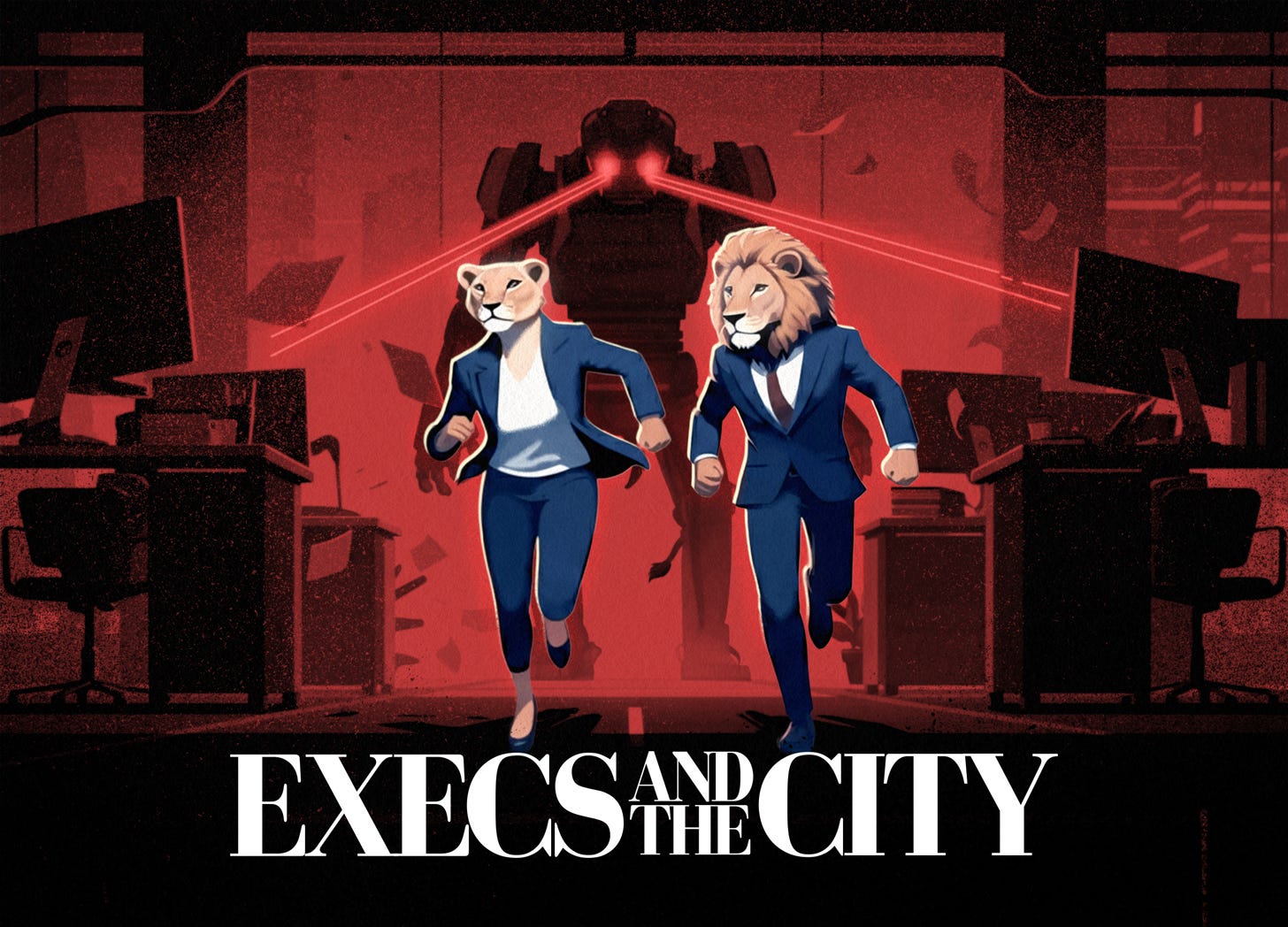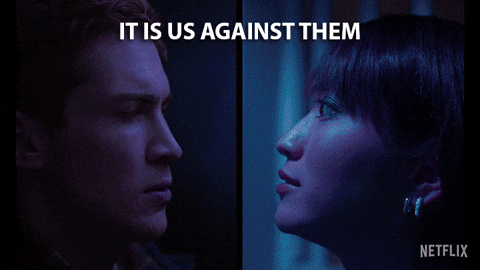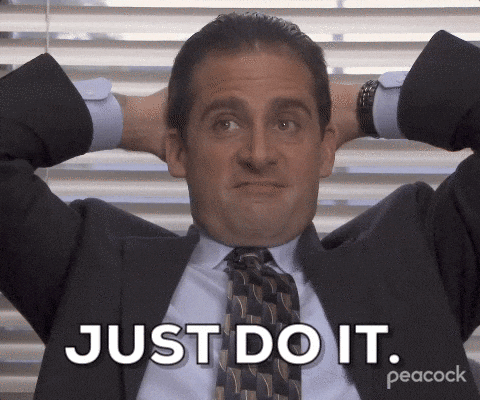The White-Collar AI Purge Is Here
A case study breaking down how one business replaced 25 people, and the cold financial logic that makes it inevitable.
Recently, a provocative LinkedIn post about AI skeptics ignited a firestorm that revealed something far more interesting than the original provocation.
The debate that followed exposed the deep psychological mechanisms driving our response to transformative technology—and why our brains are wired to choose comfortable denial over uncomfortable action.
I've spent the last decade studying behavioral psychology and its impact on executive decision-making.
What I witnessed in that LinkedIn thread wasn't just disagreement about AI's potential. It was a textbook demonstration of the cognitive biases that Daniel Kahneman and Amos Tversky systematically documented in their groundbreaking research on judgment under uncertainty.
Let me be clear.
The concerns about AI's societal impact are legitimate and necessary.
The fears about job displacement, economic inequality, and corporate power concentration are grounded in reality. All it takes is opening your eyes to the current state of our world—particularly post 9-11 and post-COVID—to recognize the widening divide between us and them.
I've built my career advocating for employees, not employers. I don’t want a dystopian hellscape any more than the next person.
My advocacy isn't about cheerleading for AI or celebrating job displacement.
It's about equipping people with the psychological frameworks and practical tools they need to protect themselves and their families when the institutions that should protect them inevitably fall short.
A Note on Pushback
I know this article will anger some readers. You'll see me as another privileged tech advocate celebrating job losses while dismissing legitimate fears as "psychological resistance."
Fair enough.
Here's what I really believe. The corporate concentration of AI power is terrifying. The human costs are real and devastating. Systemic reform is absolutely necessary. I'm not cheerleading for this reality—I'm acknowledging it exists whether we like it or not.
My case study example isn't a celebration; it's a warning.
If I could achieve massive gains through AI as a small business owner who prioritized employees, imagine what profit-driven corporations will do.
That's precisely why individual preparation matters—not instead of collective action, but alongside it.
Yes, I have privileges that made my transition easier. Yes, telling people to "just adapt" can sound dismissive when they face real barriers. But waiting for systemic change while ignoring individual agency is like refusing to learn to swim because we should be building better boats.
We need both.
I use behavioral psychology not to manipulate but to explain why smart, capable people—myself included—resist changes that threaten our identity and expertise. Understanding these patterns helps me act despite my own fears. Maybe it'll help you too.
You can think I'm wrong, naive, or complicit. But please don't mistake my pragmatism for enthusiasm. I'm not excited about this future—I'm just unwilling to pretend it's not happening.
Predictable Patterns of Psychological Deflection
What fascinated me most about the LinkedIn responses on my highly provocative post wasn't the legitimate criticism—it was watching psychological defense mechanisms play out in real time.
It’s honestly why divisive content can be so effective; although that wasn’t my intention with posting. I simply wanted a snappy take and didn’t have 20 minutes to refine.
The chaos that followed? I didn’t anticipate it. But I digress.
Kahneman and Tversky's research on the "availability heuristic" showed that people judge probability by how easily examples come to mind. In the LinkedIn thread, commenters repeatedly cited examples of AI failures or limitations while ignoring mounting evidence of successful implementations.
Their research on "confirmation bias" revealed how we seek information that supports our existing beliefs while avoiding contradictory evidence—which explains why so many responses focused on debunking AI rather than exploring adaptation strategies.
Most telling was the manifestation of what Kahneman and Tversky called "loss aversion" — the psychological principle that losses feel roughly twice as powerful as equivalent gains.
The thread was dominated by discussions of what people might lose (jobs, human connection, authenticity) rather than what they might gain through adaptation.
But beyond these well-documented biases, I observed something more troubling—something typical of LinkedIn and other social media platforms.
What psychologists call "deflection and displacement."
Rather than engaging with the core argument, many commenters fixated on peripheral elements—attacking the asteroid metaphor, the AI-generated imagery, or my appearance in a business suit.
This psychological pattern serves a specific function.
It allows people to avoid confronting uncomfortable realities by redirecting energy toward safer targets.
Even more concerning was the prevalence of ad hominem attacks that had nothing to do with the argument itself.
Comments about "men in suits" or assumptions about character revealed what social psychologists recognize as "outgroup derogation" — the tendency to dismiss ideas based on perceived group membership rather than merit.
This isn't debate; it's psychological avoidance disguised as social justice.
Now back to… the white-collar purge.
One commenter made a brilliant point that captured the real issue.
Judging the Wright Brothers' innovation by the lack of in-flight entertainment misses the point entirely. They still disrupted travel as we knew it. Just ask the coachmen about their horses and buggies.
Innovation doesn't need to be perfect to be transformative.
It just needs to be better than the status quo at performing essential functions. And to be honest, the bar really isn’t that high.
This isn't a character flaw in any individual.
It's how human psychology works under conditions of uncertainty. But recognizing these patterns is the first step toward moving beyond them. Or poking fun at them in the comments because you have no self-control.
Guilty as charged.
While we debate whether AI is overhyped, executives are already using it to eliminate entire departments.
Why Smart People Make Terrible Predictions About Their Own Future
The data tells a stark story.
According to the World Economic Forum's survey of 803 major global companies, 41% of employers worldwide intend to reduce their workforce in the next five years due to AI automation.
Goldman Sachs projects that AI could impact the equivalent of 300 million full-time jobs worldwide, with a quarter of all work tasks in the US and Europe potentially automated. Yet when professionals encounter these statistics, they exhibit predictable psychological patterns that behavioral economists have documented for decades.
These aren't abstract statistics.
In my executive advisory practice, I'm seeing it firsthand. This year, I've worked with over a dozen executives who prominently feature AI-driven headcount reduction on their resumes.
One Fortune 50 leader reduced their department from 90 people to 7—and received bonuses and board praise for the “transformation.”
When reducing human teams by 92% becomes a celebrated executive achievement, the writing isn't just on the wall—it's in their performance reviews.
We're noticing another troubling trend in our international user inquiries from India and Southeast Asia.
Professionals who've built careers on the likes of Upwork and Fiverr are experiencing a drop off and change in work.
We suspect we know what's happening.
The same American companies that moved $50/hr jobs overseas for $5/hr have found something even cheaper.
AI doesn't need sleep schedules coordinated or contracts negotiated. It just works, instantly, for pennies (when properly implemented).
It’s not just big businesses either.
When I rebuilt my business model after COVID, I discovered that functions previously requiring 25 employees—what was needed to get Discover Podium into the $1.5M+$3M range—could now be handled by AI-augmented systems.
Revenue per W2 employee jumped from $70,000 to more than $500,000 between 2020 and 2025.
This wasn't theoretical disruption—it was Tuesday morning reality.
Some employees were replaced with a few prompts, others required complex agentic flows with a strong human in the loop to guide.
I had 5 full-time writers on staff who delivered over 1,000 outputs annually for clients. Those employees cost ~$375,000 in total compensation and generated approximately $1 million in revenue—requiring constant leadership time, mentorship, guidance, correction, and management.
With AI we achieved 1,000 outputs in 3 days—with better customer reviews, faster delivery times, and more satisfied customers.
The AI cost a few thousand dollars to figure out, and each output now frees my time, grows the business, and creates self-service revenue at $7 per output with a delivery cost of 15 cents.
Do the math.
$375,000 in employee costs versus $150 in AI delivery costs for the same 1,000 outputs after a very modest investment?
That's a 2,500x cost reduction while improving quality and speed—and that's just one of the five core functions we replaced.
Plus, that doesn’t even begin to touch the value of my mental health improvement, personal hour reduction, stress of always making payroll, increase in time spent with family, and creative freedom gained.
Account management, customer success, operations, and administration eliminated another $1 million annually in headcount costs.
To be clear—I didn't replace my staff with AI.
Once I knew I wasn’t interested in leading Discover Podium anymore, I spent a year slowly helping each employee find more sustainable work and unwound the business in 2020 instead of grabbing a PPP loan, meeting minimal requirements, laying everyone off, and pocketing the rest.
It cost me everything I had, but advocating for my team and helping them land higher-paying roles remains one of my proudest accomplishments as a CEO—even though I was left penniless.
The human reality?
Most people moved on without a second thought. I learned why executives choose business logic over personal sacrifice—but I'd make the same choice again.
But on second thought, maybe I should have sold Discover Podium instead.
When I rebuilt a similar business a year later, I discovered these functions simply weren't necessary anymore.
The timing reveals why the old model became obsolete practically overnight.
What required $1.4 million in annual labor costs now operates with AI systems that cost less than most companies spend on coffee.
If a small business owner who spent all of 2020 prioritizing employee welfare over profit can achieve these results, imagine what happens when corporations with quarterly earnings pressure discover the same capabilities.
Research reveals why this disconnect exists between objective risk and subjective perception.
Behavioral psychology shows that professionals systematically underestimate personal threats even while acknowledging general dangers—a phenomenon driven by well-documented cognitive biases that serve as psychological defense mechanisms against overwhelming change.
Status Quo Bias
Daniel Kahneman's research reveals that humans have a systematic tendency to prefer current circumstances over change, even when change offers clear advantages.
This explains why LinkedIn commenters focused energy on debunking AI's capabilities rather than exploring adaptation strategies. The brain interprets technological change as a threat to established identity and competence.
Rather than confronting this threat, we unconsciously deploy psychological defenses that maintain our existing worldview.
Action vs. Inaction Bias
Behavioral psychology identifies "action bias"—our tendency to favor action over inaction even when inaction might be beneficial.
But when facing career-threatening change, we flip this bias into what I call “wait and see bias”—where doing nothing feels safer than taking action that might confirm our fears.
That's a fine position for many people.
But my work targets senior leaders, and you can't call yourself a leader if you're waiting to see what others do before you act. Leadership requires moving first, not following the crowd once the path is proven safe.
This isn't to say you shouldn't be skeptical and question everything.
Quite the contrary.
However, you must act and decide with incomplete information, then adapt as you learn. The strongest leaders have strong opinions, loosely held.
Action creates learning. Inaction lets someone else decide your actions for you.
Why Most Leaders Stay Silent When They Should Speak Up
The LinkedIn post generated overwhelming negative attention—exactly what happens when you challenge comfortable assumptions.
It led to meaningful discourse with thoughtful professionals who engaged with the substance, but it also triggered personal attacks from people who couldn't engage with the actual arguments.
This dynamic reveals why so many leaders stay silent on important topics.
They're afraid of the public backlash that comes with taking unpopular positions, even when those positions are necessary for their organizations' survival. I don’t blame them.
But there is also plenty beneath the surface of controversial posts—the private conversations they spark.
I received dozens of direct messages and texts from executives saying "I 100% agree with you—but I can't comment publicly." The general discussion was so negative that thoughtful leaders chose to engage privately rather than risk association with an unpopular viewpoint.
One commenter escalated from stereotyping "dudes in suits" to personal insults, then admitted they "didn't come in here to argue out of good faith."
These attacks reveal far more about the person making them than their target—but they successfully intimidate other leaders from joining the conversation.
There’s a Cost for Silent Leaders
It's a shame that more commentary from the most experienced leaders cannot be more public—and likely for good reason. Senior executives have boards, shareholders, and employees to consider.
Taking controversial public positions carries real professional risk that most people don't face. This isn't anyone's fault. It's simply the reality of how public discourse works in our current environment.
Side note—I got fired from a VP of Marketing position for having a provocative comment on a Facebook post about 10 years ago. Text me if you want to know what I said.
Decades of behavioral research reveal a consistent pattern.
When facing controversial topics, the most informed voices systematically withdraw from public discourse while the most reactive voices dominate the conversation.
This creates what researchers call "false consensus" — where minority opinions appear to represent majority thinking simply because thoughtful leaders choose private engagement over public risk.
The psychological mechanisms driving this pattern are well-documented across neuroscience, social psychology, and organizational behavior studies.
I won’t go into wild detail here, but here are some deeper dives if you’d like to geek out.
Supporting Research Areas:
Social Proof & Pluralistic Ignorance - People privately agree but publicly conform, creating false consensus that thoughtful leaders are outnumbered.
Best Resource: Robert Cialdini - "Influence: The Psychology of Persuasion" (Chapter 4)
Spiral of Silence Theory - Perceived minority voices withdraw from public discourse, amplifying reactive positions over informed ones.
Best Resource: Elisabeth Noelle-Neumann - "The Spiral of Silence: Public Opinion—Our Social Skin"
Status Threat Neuroscience - Public criticism activates same brain regions as physical pain, triggering threat responses that impair executive judgment.
Best Resource: David Rock - "SCARF: A Brain-Based Model for Collaborating With and Influencing Others" (NeuroLeadership Journal)
Conformity Under Uncertainty - 75% of people conform to group opinion even when they know it's wrong, with higher rates among professionals with reputational stakes.
Best Resource: Solomon Asch - "Studies of Independence and Conformity" (Psychological Monographs)
Executive Vulnerability Paradox - Leaders must model learning and uncertainty but face disproportionate punishment for appearing unsure or making mistakes.
Best Resource: Amy Edmondson - "The Fearless Organization: Creating Psychological Safety in the Workplace for Learning, Innovation, and Growth"
Intelligence Becomes a Liability During Paradigm Shifts
Kahneman and Tversky's research also revealed something counterintuitive. Intelligence doesn't protect us from cognitive biases.
Smart people are often more susceptible to certain reasoning errors because they're better at constructing sophisticated justifications for their existing beliefs.
I've witnessed this firsthand while advising executives through major career transitions. The most analytically gifted leaders often struggle most with paradigm shifts because their expertise becomes a cognitive prison.
They know their industry so deeply that they can't imagine it functioning differently. In other words, they’re too close to it. I’m highly guilty of this in my business as well.
This explains why so many thoughtful professionals dismiss AI's impact.
They're not being naive—they're being human.
Their expertise in current systems makes it psychologically difficult to envision those systems becoming obsolete—especially when their financial survival depends on everything staying the same.
Or perhaps the burden of all the continuous learning necessary to adapt is getting frustrating to keep up with. It seems like we can never keep up and we’re always outmatched. Sigh.
But here's where understanding this psychological trap becomes your competitive advantage. While others remain paralyzed by their expertise, you can use behavioral psychology to move first.
The Narrative Preamble Strategy
In negotiation psychology, we teach clients about "narrative preamble"—getting ahead of the story before others can write it for you.
The same principle applies to technological disruption.
Those who act early get to shape their own transition narrative. Those who wait have their story written by market forces beyond their control.
Current data shows we're experiencing what researchers call "The White-Collar Recession of 2025"—corporate profits remain robust while hiring for professional roles has slowed dramatically.
The narrative is being written now, while many are still debating whether the pen exists.
Your Three-Stage Action Framework
Fortunately, your successful adaptation follows a predictable pattern.
Stage 1: Psychological Acceptance
Stop debating whether change will happen and start preparing for how it will affect you specifically.
Spend 30 minutes daily working directly with AI tools in your domain. Don't delegate this learning—understand capabilities and limitations firsthand. Most professionals who dismiss AI haven't spent meaningful time learning to use it effectively.
Stage 2: Skill Integration
Map your current role against tasks requiring human judgment, relationship management, or creative synthesis. These become your areas of focus and development.
Develop skills that complement AI capabilities rather than compete with them—prompt engineering, AI system management, or human-AI collaboration techniques. Start by knocking out basic and repetitive jobs to be done (JTBD) and move up the value you chain as your skills improve.
Stage 3: Position Optimization
Network forward, not backward. Connect with professionals who are successfully integrating AI into their work rather than those resisting it.
Your network shapes your opportunities more than your expertise shapes your network.
The Psychological Advantage of Taking Action
Early action creates psychological momentum that compounds over time.
When you start learning AI tools before you need them, you develop confidence that makes subsequent learning easier. When you begin networking with AI-savvy professionals before it's urgent, you build relationships that open unexpected opportunities.
When you start thinking about your career in AI-integrated terms before it's required, you develop strategic clarity that guides better decisions.
This compound effect explains why some professionals seem to thrive during disruption while others struggle. They're not smarter or luckier—they're psychologically positioned for acceleration rather than resistance.
An Uncomfortable Truth About Timing
People have lost jobs to AI automation this year. Companies have expressed preference to solve with AI first versus hiring.
The August 1st jobs report showcased the most dramatic downward revisions to employment growth since the onset of the COVID-19 pandemic, with the timeline accelerating beyond most predictions.
We suffer from what researchers call "exponential growth bias"—our linear-thinking brains struggle to comprehend accelerating change.
This is why so many professionals are caught off guard by technological shifts.
Once you recognize the bias, you can compensate for it. You can make decisions based on exponential possibilities rather than linear projections.
Beyond Individual Action
Many of my LinkedIn critics are right—AI development is largely controlled by massive corporations with interests that don't align with worker welfare.
Also — duh…
This concentration of power creates legitimate concerns about who benefits from increased productivity and who bears the cost of displacement.
But focusing all your energy on criticizing power structures we can't directly control diverts attention from developing personal agency we can control.
I call it punching the air.
We need better retraining programs, progressive taxation of AI-generated productivity gains, and stronger social safety nets.
But we also need individuals who understand the technology well enough to shape these conversations intelligently. The LinkedIn debate revealed a false choice between individual adaptation and systemic reform. We need both.
A Dual-Track Strategy—Adapt & Advocate
While you're building AI skills individually, simultaneously:
Join or form an AI Ethics Committee at your company — Shape how AI gets implemented rather than just reacting to it.
Document and share transition playbooks — When you successfully integrate AI into your role, create guides that help colleagues do the same without job loss.
Advocate for "AI dividends" — Push your organization to share productivity gains through profit-sharing, reduced hours for same pay, or retraining budgets.
Build coalition networks —Connect with others in your industry who are navigating AI transitions to share strategies and amplify worker voices.
Propose pilot programs — Suggest testing AI augmentation (not replacement) models that demonstrate how human+AI partnerships create more value than either alone.
A Final Note on Nuance and Reality
While the call for immediate, personal action is the core of this argument, it's important to approach this transition with a dose of nuance.
First, individual adaptation and the push for systemic reform are not mutually exclusive.
While focusing on what you can control is pragmatic, true leadership also involves advocating for responsible corporate behavior and robust social safety nets. Shaping the new system is as important as succeeding within it.
Second, my own business transformation serves as a stark case study, but it's one born from the agility of a nimble rebuild.
Integrating these tools into a large, established enterprise with legacy systems and a complex culture presents a fundamentally different and more difficult challenge.
Finally, the reality of AI implementation is far more complex than "a few prompts." Achieving quality results requires significant human expertise for strategic oversight, quality control, prompt engineering, and managing the clear ethical risks. The goal is to augment human intelligence, not to attempt a simplistic replacement.
Embrace action, but do so with a clear-eyed view of the full picture.
Your Choices Define Your Career
You’re facing this technological transition and have a fundamental choice.
Not about whether AI will transform your industry—that's already decided. Not about whether the transformation will be fair or comfortable—it won't be.
The choice is about how you’ll position yourself
relative to forces you can't control.
Will you focus your energy on resistance, analysis, and debate? Or will your focus on adaptation, skill development, and strategic positioning?
Five years from now, you'll tell a story about how you navigated this AI transition. That story is being written now, through decisions you make while change still feels manageable.
You can write a story about how you saw disruption coming and positioned yourself to benefit from it. Or you can write a story about how change happened to you faster than you expected.
Both stories are valid. Only one is strategic.
That Fortune 50 executive who eliminated 83 jobs? They're being promoted right now. While you're reading this, they're writing the playbook for all of us.
The time for action is now.
Need help applying this? Upgrade to paid for monthly live sessions with Jacob.
Stay fearless, friends.











Thanks for the well presented article. We humans can certainly get in our own way. The AI disruption is only going to accelerate and denial won’t prove to be a satisfying strategy. We can either grab the wheel and start driving or get into the back seat and see where it takes us.